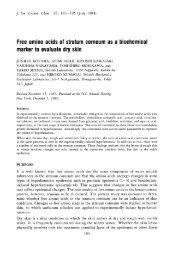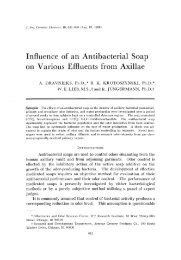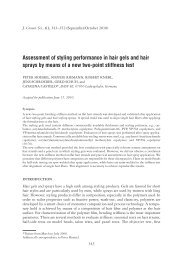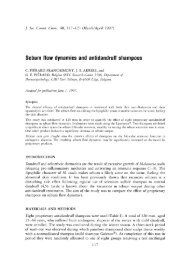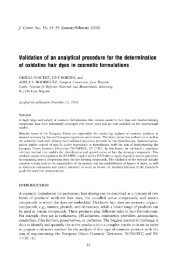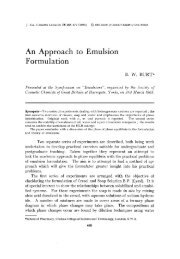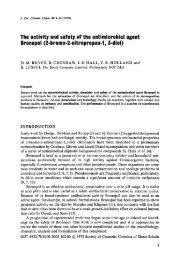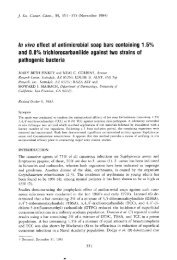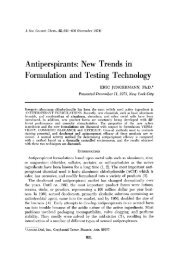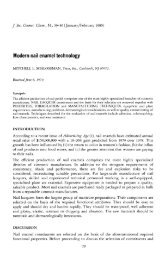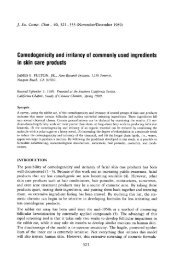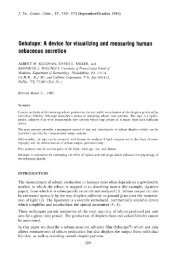A Critical Comparison of Two Procedures for Antiperspirant Evaluation
A Critical Comparison of Two Procedures for Antiperspirant Evaluation
A Critical Comparison of Two Procedures for Antiperspirant Evaluation
Create successful ePaper yourself
Turn your PDF publications into a flip-book with our unique Google optimized e-Paper software.
9.74 JOURNAL OF THE SOCIETY OF COSMETIC CHEMISTS<br />
The RM gives estimates <strong>of</strong> per cent reduction which have been modified<br />
by the a priori mean ratio obtained at the time <strong>of</strong> the pretest measurements.<br />
If this mean ratio were constant, it would not alter the per cent reduction<br />
obtained relative to that <strong>of</strong> the SSEM. To the extent that this is not true, the<br />
per cent reduction will be differenthan that given by the SSEM. Since it has<br />
been shown that the ratios can be quite variable, it follows that the per cent<br />
reduction estimates obtained may be substantially altered. This difference in<br />
the estimates is obviously a function <strong>of</strong> the degree <strong>of</strong> variability <strong>of</strong> the pretest<br />
ratios. Under these circumstances, the precision <strong>of</strong> the estimate becomes irrelevant<br />
even though it is a function <strong>of</strong> the number <strong>of</strong> pretest determinations<br />
as well as the factors operating in the SSEM. A questionablestimate is not<br />
improved by reducing its variability.<br />
It is possible, however, to utilize pretest data in a statistically valid manner<br />
to adjust posttest results by the use <strong>of</strong> an analysis <strong>of</strong> covariance, and this<br />
procedure might be shown to give more accurate, and precis estimates <strong>of</strong> p;'r<br />
cent reduction than those given by the SSEM, if the pretest data are sufficiently<br />
well-correlated with the posttest ratio. The mathematics <strong>of</strong> such an<br />
analysis, however, differ from those <strong>of</strong> the ratio adjustment procedure, and it<br />
is impossible to predict results without experimentation. When time permits,<br />
we plan to investigate this matter. Meanwhile we recommend the SSEM over<br />
the RM as the scientifically valid method, as well as the one <strong>of</strong> choice on the<br />
bases <strong>of</strong> simplicity and low costr<br />
ACKNOWLEDGMENTS<br />
We wish to thank Dr. John Mandel <strong>for</strong> statistical advice xvhich has been helpful in<br />
clarifying our thinking regarding a number <strong>of</strong> points. In addition, Mr. Giles Crane has<br />
contributed statistical assistance, and Miss Linda Timberlake per<strong>for</strong>med a large nmnber cf<br />
statistical analyses in preparing the experiments. Finally, we would like to express our<br />
gratitude to the Editor and reviewers <strong>of</strong> this Journal <strong>for</strong> their careful, complete, and very<br />
comtructive comments.<br />
(Received November 12, 1974)<br />
REFERENCES<br />
(1) W. G. Fredell and R. R. Read, <strong>Antiperspirant</strong>-axillary method <strong>of</strong> determining effectiveness,<br />
Proc. Sci. Sect. Toilet Goods Ass., 23-7 (1951).<br />
(2) W. G. Fredell and J. Longfellow, Report on evaluating antiperspirant and deodorant<br />
products, ]. Soc. Cosmet. Chem., 9, 108-11 (1958).<br />
(3) E. W. Daley, Antispliant testing: A comparison <strong>of</strong> two methods, Proc. Sci. Sect.<br />
Toilet Goods Ass., 1-6 (1958).<br />
(4) P. A. Majors and John E. Wild, The evaluation <strong>of</strong> antiperspirant e•cacy-infi'tence <strong>of</strong><br />
certain variables, ]. Soc. Cosmet. Chem., 25, 139 -2 (1974).<br />
(5) W. M. Woocling, The interpretation <strong>of</strong> gravimetric axillar antlperspirant d._•tx, P:oc.<br />
Joint Con[. Cosmet. Sci, 91-105 (1968).<br />
((") N. R. Draper and H. Smith, Applied Begres•ion Analysis, John Wiley & Sons, Inc.,<br />
New York, 1966, chap. 3.<br />
(7) F. J. Anscombe and J. W. Tukey, The examination and analysis <strong>of</strong> residuals, Technomet,•ics,<br />
5, 141--60 (May 1963).



